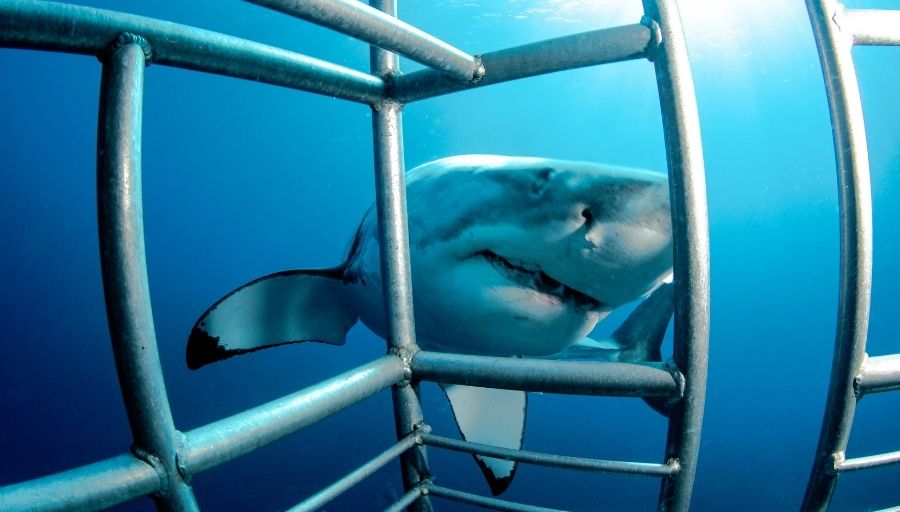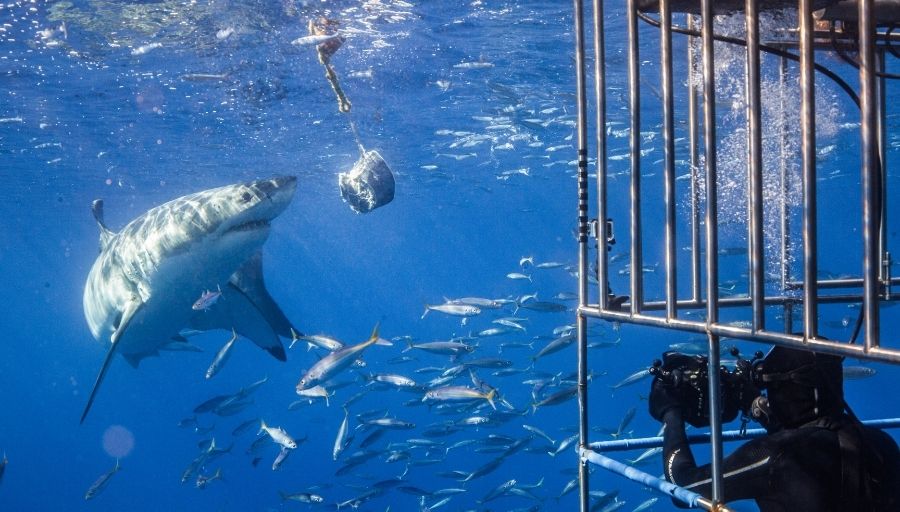Cage diving with great white sharks has becoming increasingly popular amongst tourists, especially in South Africa. This activity allows people a very up-close-and-personal experience with these fearsome fish from the safety of a specially-constructed, floating cage. With only steel bars between the cage’s passenger and a hungry Great White Shark, this promises a truly unique, adrenalin-inducing experience.
Great White Shark Cage Diving
The first shark cage was developed by Jacques Cousteau. He was inspired by the documentary ‘Silent World’ and he nearly died in one of his first designs in 1963.
Great white sharks have the habit of lifting their heads out of the water to catch a better glimpse of its prey as well as to smell it better, as scent travels better in air than in water. This offers viewers an incredible look at this mammoth’s snout, teeth and head. Be sure that the tour on which you go does not actually feed the shark and does not pull or push it in any way, as this may traumatise and hurt the animal.
Great White Sharks are lured to the boat using a slick of crushed sardines and chunks of raw flesh dangled in the water. Their enhanced ability to smell this meat creates an irresistible urge in them to follow the scent in pursuit of a meal. Once near the boat, the passengers are already able to witness them from above as they chase the prey and perhaps engage in a tug-of-war with the crew on the boat, who are controlling the rope with the meat at the end of it.

Travellers with a greater sense of adventure will then climb into the floating steel cage, which is attached to the boat. There are portals through which those inside the cage are able to see the shark without bars to hinder their view. The sharks may come right up to the cage and even gnaw on the bars, but its occupants are safe and protected. This is an exhilarating experience; witnessing these powerful hunters within their own habitat, as they curiously explore the cage and boat.
Visitors do not require any sort of certification in order to enter the cage, and are able to take photographs with underwater cameras. Trained and prepared crew are available at all times during formal shark cage dives and are able to remove you from the water should you feel nervous or should you prefer to view these animals from above.
How Dangerous Is Shark Cage Diving?
Shark cage diving is dangerous for the sharks. Not for the humans. On average 65 shark attacks are reported annually since 2000 and only 5 are fatal. But none of the attacks happen to shark cage divers. No fatal attack has been reported so far. No cage have been broken although some cases have been scary for the cage divers.
Be aware that shark cage diving can cause harm to the sharks. Shark cage diving is considered unethical if they are baited.
Shark Cage Diving Accident
Only a few shark cage diving accident have been reported. One accident happend in 2005 in South Africa when a British tourist was ‘attacked’ by a great white shark. The great white shark managed to destroy one of the floatation buoy and the cage diver had to swim to the surface. The cage diver was unharmed and but the shark was because the captain jabbed his head to disorientate the animal.
Underneath another accident with a great white shark trying to break open the shark cage with diver still inside off Mexico coast. The diver was unharmed but very shaky.
Why Shark Cage Diving Is Bad
Despite a guaranteed adrenalin rush, there have been several disagreements from researchers and environmentalists concerning shark cage diving over the years. These ones argue that using food to lure sharks draws them into an area they may not usually enter, which is generally closer to the shore and, by implication, closer to future bathers, divers and surfers. This may cause them to frequent these areas in search of food in the future and increase aggressive behaviour towards humans.

In addition, it is surmised that throwing bait in the water may cause sharks to associate food with human beings and boats, which implies another possibility of future attacks. There are also some rudimentary research initiatives that have raised the issue of the electromagnetic forces emitted by the cage and the propeller of the boat. These stimulate the shark’s senses, particularly the Ampullae of Lorenzini, and may actually cause some sort of long-term damage in their sensory perceptions. As with any encounter with the natural world around us, it is important to minimise human impact, while still revelling in the excitement and fascination of the experience.
